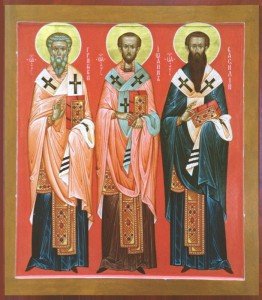 The Cappadocian Fathers stressed the fact that in the economy of salvation (this is the typical way that the Fathers expressed the process of salvation), the Son and the Spirit are inseparable: “When the Word dwelt upon the holy Virgin Mary,” Athanasius writes, “the Spirit, together with the Word, entered her; in the Spirit, the Word fashioned a body for Himself, making it in conformity with Himself, in His will to bring all creation to the Father through Himself.”
The Cappadocian Fathers stressed the fact that in the economy of salvation (this is the typical way that the Fathers expressed the process of salvation), the Son and the Spirit are inseparable: “When the Word dwelt upon the holy Virgin Mary,” Athanasius writes, “the Spirit, together with the Word, entered her; in the Spirit, the Word fashioned a body for Himself, making it in conformity with Himself, in His will to bring all creation to the Father through Himself.”
I would ask my readers to stop and think about these words of Athanasius (he was not a Cappadocian Father but was together with them in thought). They are profound and give a clearer picture of how the Spirit works. It is the power of God that actually makes real what God intends.
The main argument, in favor of the consubstantiality of the Spirit with the Son and the Father, (you will note that the Church had to make arguments about each of the Three Persons of the Trinity since it is a very complex, religious concept) used by Athanasius and Cyril of Alexandria and by the Cappadocian Fathers, is the unity of the creative and redemptive action of God, which is always Trinitarian: “The Father does all things by the Word in the Holy Spirit” (this is the basic understanding of the working of the Trinity that was developed by the Eastern Fathers).
The essential difference between the action of the Word and that of the Spirit is that the Word, and not the Spirit, became man, and thus could be directly seen as the concrete person and hypostasis of Jesus Christ, while the personal existence of the Holy Spirit remained covered by divine incognoscibility. The Spirit, in His action, reveals not Himself but the Son; when He indwells in Mary, the Word is being conceived; when He reposes on the Son at the baptism in Jordan, He reveals the Father’s good will toward the Son. This is the Biblical and theological basis of the very current notion, found in the fathers and in the liturgical texts, of the Spirit as image of the Son, while the Son Himself is the image of the Father. In the context of a dynamic thought, the static Hellenic concept of image reflects a living relationship between the divine persons, into which, through the incarnation of the Son, mankind is introduced.
It is this understanding of the way that the Trinity works that has caused the Eastern Church to retain the original form of the Creed which states that the Spirit proceeds from the Father and not the Father and the Son.
